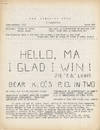
Dafangguangfo Huayanjing shu ("Commentary on the Flower Garland Sutra").: Fascicle LXXX.
by KOREAN EARLY PRINTING
- Used
- Condition
- See description
- Seller
-
London, United Kingdom
Payment Methods Accepted
About This Item
Korea: Liangzhe zhuanyunsi,, [c.1087]. Korean woodblock printing of the 11th century An exceptionally rare and well-preserved 11th-century testament to the vital role of print in spreading Buddhist thought throughout East Asia. This fascicle, from a major Chinese-language critical edition of the Flower Garland Sutra (Huayan Buddhism's foundational text), was printed in Korea from blocks engraved in Hangzhou, China. Collections of different fascicles are found institutionally in East Asia; this is the only example traced in commerce in the West. Following the arrival of Buddhism in China in the first century CE, practitioners innovated a number of Sinicized traditions including the Huayan school, one of the "most philosophically interesting and historically influential Buddhist schools" (Stanford Enyclopedia of Philosophy). Its leading text, the Flower Garland Sutra (Avatamsakasutra), "presents a dizzyingly complex and intricate vision of reality as thoroughly 'interpenetrating', of Buddhahood as coextensive with all there is, and of the features of reality as completely dependent upon the mind and deeds of sentient beings" (ibid.). By the seventh century, Huayan Buddhism had spread to Korea, where it took root and continued to evolve. By the dawn of the second millennium, East Asia had an advanced printing culture. Between 1011 and 1087, Korea's Goryeo dynasty (918-1392) organized the printing and dissemination of the Tripitaka Koreana, an expanded canon of Buddhist texts. To supplement this core body of Buddhist textual learning, the leading Korean monk Uich'on (1055-1101) travelled across East Asia between 1073 and 1090 to amass the latest commentaries and interpretations of the canon. In 1085-6, he was based in Hangzhou and studied with Jingyuan, the monk who had succeeded in "putting Huayan teachings on the Song Buddhist map as a discretely organized institutional tradition" (Stevenson, p. 365). With him, he brought a copy of a critical commentary on the Flower Garland Sutra which had been written by the Chinese monk Chengguan (738-839) but later suppressed by China's Tang dynasty. In Hangzhou, Uich'on commissioned the Liangzhe zhuanyunsi (Zhejiang Tax Transport Bureau) to engrave woodblocks for a new 120-fascicle edition of the Chengguan commentary embellished with Jingyuan's exegesis. These blocks, approximately 1,500 in total, were delivered to Korea in 1087 by the Chinese merchant Xu Jian. The clarity of the printing suggests this is an early impression on distinctive Korean mulberry paper (Broussonetia papyrifera). Surviving volumes from this 120-volume edition are found printed on both Chinese and Korean paper, suggesting that, in addition to copies printed in Korea, some were printed in China before Xu Jian's departure to furnish Chinese Buddhists with access to the forgotten Chengguan commentary. Throughout the rest of the Goryeo dynasty, Huayan remained a leading Buddhist school in Korea, and in succeeding centuries it would merge with other sects to form a new syncretic tradition. In 1372, a frontispiece illustration was engraved in Korea for a new printing from the 11th-century blocks. In 1424, the blocks were transferred to Japan's Shokokuji Buddhist temple, where they were destroyed by fire. According to the catalogue of the Archives of Buddhist Culture at Dongguk University, 43 fascicles are held at Keimyung University, while the National Library of China holds 6 printed in Hangzhou. Collections of one or two fascicles on Chinese and Korean paper appear in different institutions in Korea, China, and Japan. The catalogue records just one copy of the present fascicle. Provenance: Christie's New York, Japanese and Korean Art, 18 April 2018, lot 129; private collection, UK. Slim quarto, concertina-style (315 x 110 mm). 24 woodblock-printed sheets, each with 20 columns, joined sequentially with adhesive as issued, bound within early, perhaps contemporary, indigo-dyed paper covers, manuscript title in gilt. Housed in custom folding card case with purple ties and manuscript title label. Covers and contents with a few old stains, text with tidemarks and a little worming in margins. A well-preserved copy. Daniel B. Stevenson, "Buddhist Ritual in the Song", in John Lagerwey & Pierre Marsone (eds.), Modern Chinese Religion, Volume I, 2014, pp. 328-450.
Reviews
(Log in or Create an Account first!)
Details
- Bookseller
- Peter Harrington
(GB)
- Bookseller's Inventory #
- 159674
- Title
- Dafangguangfo Huayanjing shu ("Commentary on the Flower Garland Sutra").
- Author
- KOREAN EARLY PRINTING
- Book Condition
- Used
- Place of Publication
- Korea: Liangzhe zhuanyunsi,
- Date Published
- [c.1087]
Terms of Sale
Peter Harrington
All major credit cards are accepted. Both UK pounds and US dollars (exchange rate to be agreed) accepted. Books may be returned within 14 days of receipt for any reason, please notify first of returned goods.
About the Seller
Peter Harrington
Biblio member since 2006
London
About Peter Harrington
Since its establishment, Peter Harrington has specialised in sourcing, selling and buying the finest quality original first editions, signed, rare and antiquarian books, fine bindings and library sets. Peter Harrington first began selling rare books from the Chelsea Antiques Market on London's King's Road. For the past twenty years the business has been run by Pom Harrington, Peter's son.
Glossary
Some terminology that may be used in this description includes:
- Gilt
- The decorative application of gold or gold coloring to a portion of a book on the spine, edges of the text block, or an inlay in...
- New
- A new book is a book previously not circulated to a buyer. Although a new book is typically free of any faults or defects, "new"...
- Quarto
- The term quarto is used to describe a page or book size. A printed sheet is made with four pages of text on each side, and the...






